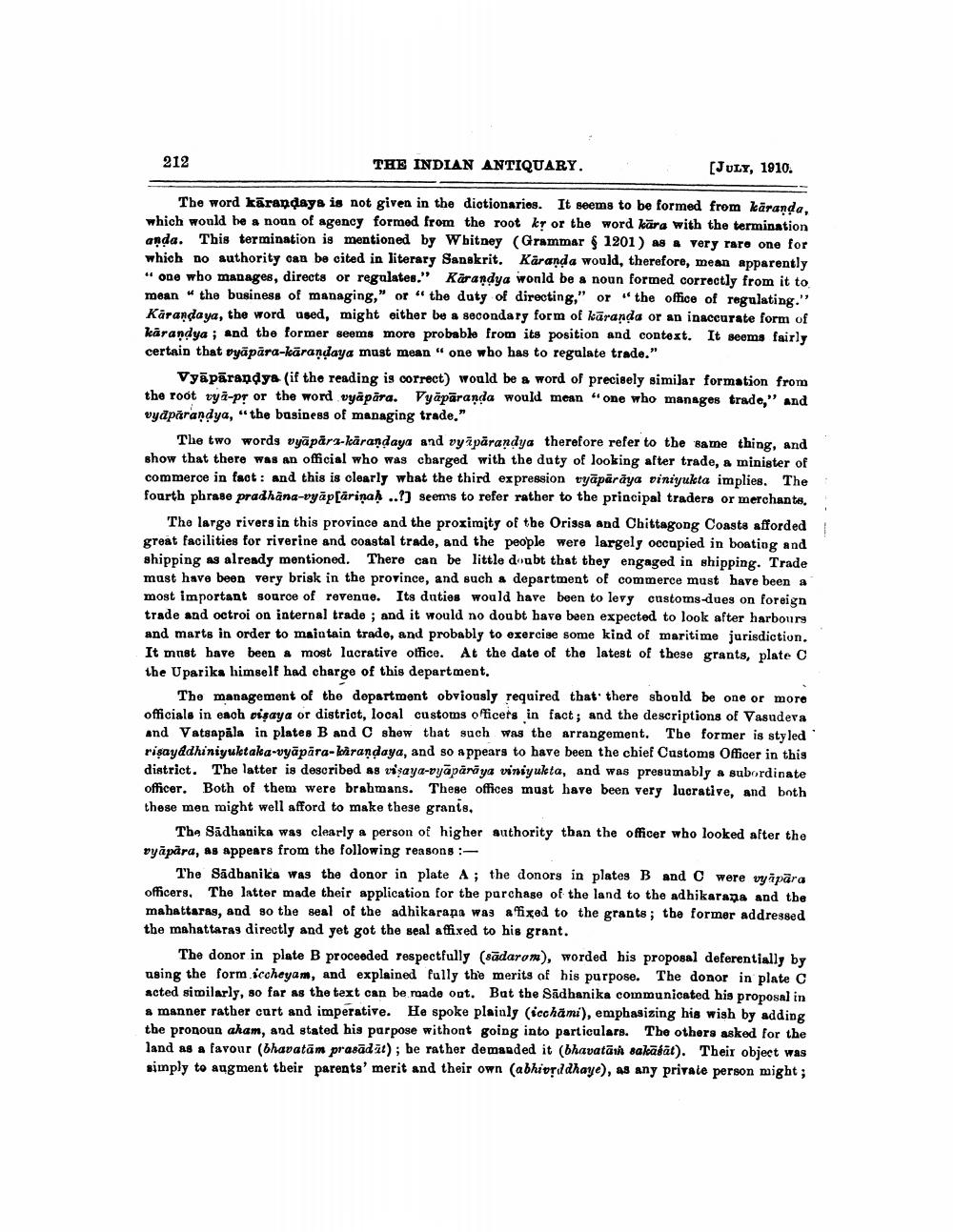________________
212
THE INDIAN ANTIQUARY.
[JULY, 1910.
The word kärandays is not given in the dictionarios. It seems to be formed from käranda, which would he a noun of agency formed from the root ky or the word kāra with the termination anda. This termination is mentioned by Whitney (Grammar 1201) as very rare one for which no authority can be cited in literary Sanskrit. Karanda would, therefore, mean apparently "one who manages, directs or regulates." Rärandya wonld be a noun formed correctly from it to mean the business of managing," or "the duty of directing," or "the office of regulating." Karandaya, the word used, might either be a secondary form of kāranda or an inaccurate form of kärandya ; and the former seems more probable from its position and context. It seems fairly certain that vyäpära-kärandaya must mean" one who has to regulate trade."
Vyāpārandya (if the reading is correct) would be a word of precisely similar formation from the root tyi-pr or the word vyäpära. Vyāpāranda would mean "one who manages trade," and vydpärandya, “the business of managing trade."
The two words vyāpara-karandaya and vyāpārandya therefore refer to the same thing, and show that there was an official who was charged with the duty of looking after trade, & minister of commerce in fact : and this is clearly what the third expression vyāpārāya diniyukta implies. The fourth phrase pradhana-vyāp[ärinah ..!) seems to refer rather to the principal traders or merchants.
The larga rivers in this province and the proximity of the Orissa and Chittagong Coasts afforded great facilities for riverine and coastal trade, and the people were largely occupied in boating and shipping as already mentioned. There can be little doubt that they engaged in shipping. Trade must have been very brisk in the province, and such a department of commerce must have been a most important source of revenue. Its duties would have been to levy customs dues on foreign trade and octroi on internal trade; and it would no doubt have been expected to look after harbourg and marts in order to maintain trade, and probably to exercise some kind of maritime jurisdiction. It must have been a most lacrative office. At the date of the latest of these grants, plate C the Uparika himself had charge of this department,
The management of the department obviously required that there should be one or more officials in each pişaya or district, local customs officers in fact; and the descriptions of Vasudera and Vatsapala in plates B and C shew that such was the arrangement. The former is styled risayddhiniyult ala-vyāpära-Kirandaya, and so appears to have been the chief Customs Officer in this district. The latter is described as visaya-vyāpārāya viniyukta, and was presumably a subordinate officer. Both of them were brahmans. These offices must have been very lucrative, and both those men might well afford to make these grants,
The Sadhanika was clearly a person of higher authority than the officer who looked after the vyāpāra, as appears from the following reasons :
The Sādbanika was the donor in plate A; the donors in plates B and were vyäpāra officers. The latter made their application for the purchase of the land to the adhikarana and the mahattaras, and so the seal of the adhikarana was a fixed to the grants; the former addressed the mahattaras directly and yet got the seal affixed to his grant.
The donor in plate B proceeded respectfully (sādarom), worded his proposal deferentially by using the form iccheyam, and explained fully the merits of his purpose. The donor in plate C acted similarly, so far as the text can be roade ont. But the Sadhanika communicated his proposal in a manner rather curt and imperative. He spoke plainly (icchami), emphasizing his wish by adding the pronoun aham, and stated his parpose withont going into particulars. The others asked for the land as a favour (bhavatām prasādāt); be rather demanded it (bhavatāri sakagāt). Their object was simply to augment their parents' merit and their own (abhiorddhaye), 48 any private person might;




